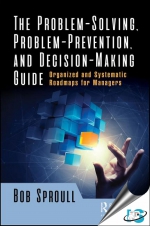Tab Article
Each day, managers and employees are confronted with a plethora of real problems and decisions that are creating issues suchs as lost throughput, poor quality, personnel problems, and material shortages.How they approach these daily quandaries will determine how successful they are at resolving problems and making effective decisions. It is human nature for managers to solutions before they even understand the nature of the problems they are trying to solve. As a result, they end up making blind decisions that change perfectly acceptable processes for incorrect reasons.
The real secret to solving problems does not depend upon the number of sophisticated statistical tools that one applies -- The secret to solving most problems is to keep the approach simple and uncomplicated. Many managers and employees make mistakes because they fail to do what Toyota does so effortlessly. They fail to perform the 'genmba walk,' during which they go to see the actual process, understand the work, ask questions, and learn.
By following a structured approach, and using only simple tools, most problems can be solved, effective decisions can be made, and problems prevented. The cornerstones of this book are three detailed roadmaps for solving problems, preventing problems, and making effective decisions. Each roadmap contains a step-by-step explanation on how to solve existing problems, how to prevent future problems, and how to make effective decisions. The book provides real case studies to illustrate each of the techniques presented in the book.


